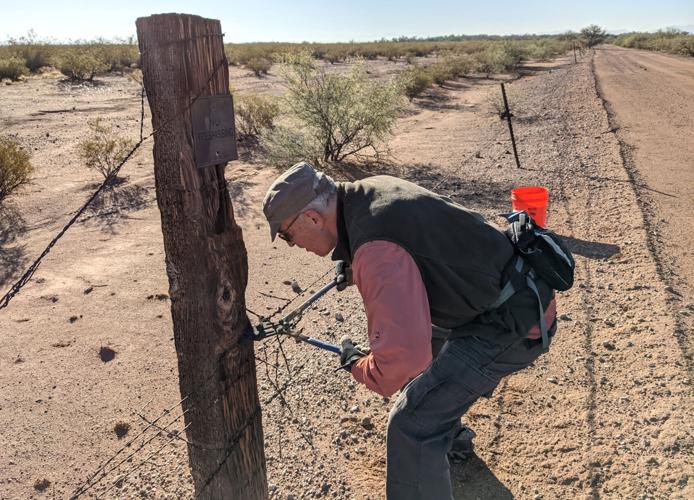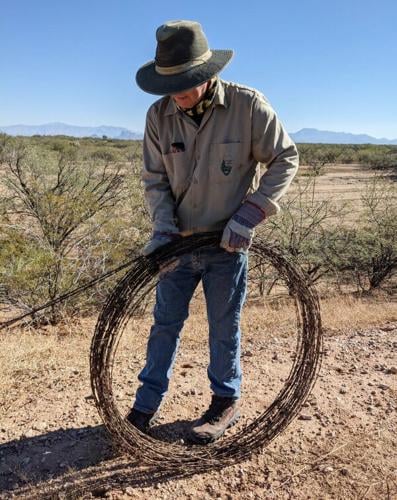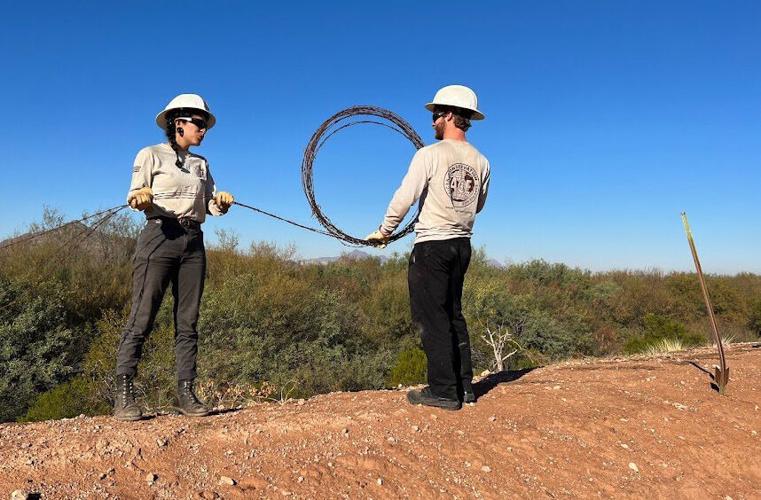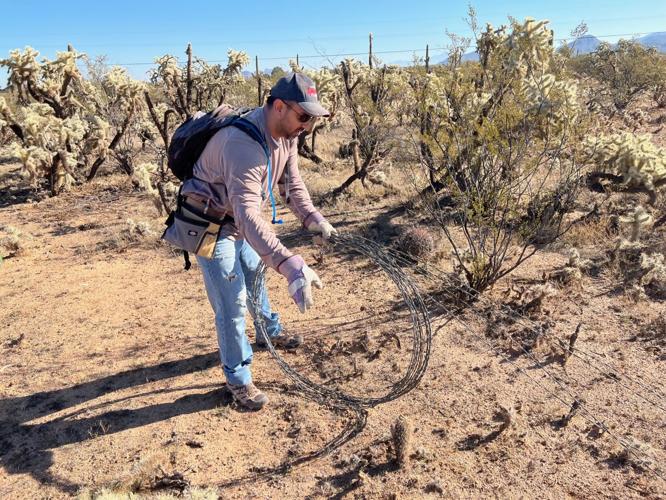The fight to protect wildlife west of Tucson could come down to the wire.
A team of government agencies and conservation groups has launched an effort to take down old, barbed wire fences on public land in Avra Valley to ease the movement of deer, bighorn sheep and other animals.
Some four miles of abandoned fencing has been ripped out since December, but no one knows exactly how much more is left.
“There are miles and miles of fences out there,” said Scott Sprague, road ecologist for the Arizona Game and Fish Department. “We’re looking to remove the fence that isn’t necessary, and modify the fence that is necessary" so it’s not a trap for wildlife.
Saguaro National Park biologist Don Swann said fencing has the potential to alter or block the movement of mule deer, bighorn sheep and even javelina, as the animals move between the Tucson Mountains and the ranges to the west.
The barbed barriers, some of them dating back 100 years or more, represent yet another obstacle in wildlife travel corridors already fragmented by roads, residential development and the Central Arizona Project canal.

Saguaro National Park biologist Don Swann coils old barbed wire that was removed from public land in Avra Valley on Dec. 11 to make it safer and easier for wildlife to move through the desert.
Swann said disrupting the movements of certain species can set off “cascading ecological effects” in the areas they used to frequent.
Fences can also be fatal. Occasionally, an animal will get its legs tangled in the wire while trying to jump over it. If it can't get free, it can mean a gruesome death.
Sprague said he’s personally come across the remains of a handful of animals that were killed that way. At least one such carcass has been reported in Avra Valley. “It’s awful finding that stuff,” he said.
Teardown team
Partners in the fence removal project include the park service, the Game and Fish Department, the Coalition for Sonoran Desert Protection, Friends of Ironwood Forest, Friends of Saguaro National Park, Friends of Buenos Aires National Wildlife Refuge, Tucson Audubon Society, Arizona Wildlife Federation and others.
“Everybody agrees that this is a pretty big problem for wildlife,” said Carolyn Campbell, executive director of the nonprofit Coalition for Sonoran Desert Protection. “It’s just so overwhelming. It’s like getting rid of buffelgrass.”
The teardown team held its first wire roundup on Dec. 11, when more than 65 people turned out to take down 3 miles of fence from a patch of public land in Avra Valley.
The second event took place Feb. 26 and drew 15 volunteers, who cut down and hauled away about a mile of fence in two sections from the western edge of Saguaro National Park.
Swann said that stretch of barbed wire near Sanders Road and Sweetwater Drive used to mark the boundary line of what was then Saguaro National Monument, before it was expanded and upgraded to a national park in 1994.
The team’s next gathering is set for March 10-12 in the Three Points area, where Tucson Water purchased agricultural land in the 1970s and 1980s to secure the associated groundwater rights.
Campbell is expecting another crowd of eager helpers. She said the fence projects so far have drawn more interest than she expected, considering the labor involved.
“Removing fencing isn’t like picking up trash or checking wildlife cameras. It’s kind of hard work,” she said.

American Conservation Experience interns Vic Villasenor, left, and Trevor Brant coil old, barbed wire during a fence removal event in Avra Valley on Dec. 11.
A western worry
Interest in wildlife movement through the area intensified after Avra Valley was identified in 2013 as a possible route for the proposed Interstate 11 between Nogales and Reno, Nevada.
Swann said the current focus on fencing was inspired by a pair of bighorn sheep that crossed the CAP canal and made their way into the west side of Saguaro National Park in 2016.
He said barbed wire represents a major barrier to wildlife migration across the Western U.S., which is home to some 600,000 miles of fencing, enough to circle the Earth along the equator 24 times.
In one study of pronghorn antelope in Wyoming, Swann said, researchers found barbed wire scars on the backs of up to half of the animals.
There are no pronghorn in Avra Valley, but wildlife cameras there have captured mule deer being turned away by wire fences.
Swann said it could take several years to get a handle on the problem, in part because no one has a clear idea of its scale.
Saguaro has been closed to grazing since the last livestock permit was retired in the 1970s, he said, but patches of fencing keep cropping up in the east and west districts of the park.
“The more we hike around and look for it, the more we find,” Swann said, some of it “old grazing allotment fences that haven’t been needed for 50 years.”
As for the fences that are still in use, like the ones marking the perimeter of the park, he said they will be restrung to make them more wildlife friendly.
That involves replacing the top and bottom strands with smooth wire to allow wild animals to crawl under or jump over them without being scratched up or entangled. The wires can also be spaced differently to keep cattle out while allowing wildlife to pass through safely.

Volunteer Ajay Madhvani rolls up barbed wire during a fence removal project in Saguaro National Park's Tucson Mountains District on Feb. 26.
Campbell said the removal team has been targeting the “low-hanging fruit” so far, but future fence projects in Avra Valley could be shaped using data collected by wildlife cameras and tracking collars to identify migration corridors.
“We want to have a handle on where the wildlife is still moving and where it isn’t,” she said.
Though the fence project extends well beyond the national park, Swann said Saguaro can only benefit from improved “wildlife connectivity” across Avra Valley.
“Animals don’t recognize boundaries,” he said. “In order to protect wildlife in the park, we have to protect wildlife around the park. The only way we can do that is by working with our partners.”
Arizona's National Parks and Monuments
Saguaro National Monument in Tucson was created in 1933, expanded in 1961, and became Saguaro National Park in 1994. There are two units: East…
Fort Bowie was an Army outpost the served as the staging point for the hunt for Apache Indian leader Geronimo. It had a short and bloody histo…
Established in 1937 by Pres. Franklin Roosevelt, Organ Pipe NM in Southwestern Arizona encompasses more than 330,000 acres, much of it wildern…
Chiricahua National Monument near Willcox, Ariz., established in 1924, is a wonderland of standing-up rocks: pinnacles, spires, sheer stone co…
The site protects one of the largest prehistoric structures ever built in North America.
The Franciscans began work on the mission at Tumacacori in 1800, but the bell tower was never finished. President Theodore Roosevelt proclaime…
Under-the-radar and usually not crowded: The three national monuments easily accessible from Flagstaff – Wupatki, Sunset Crater and Walnut Can…
The Grand Canyon in Northern Arizona was designated a national park in 1919. Along with Yellowstone and Yosemite, it is one of the crown jewel…
WATCH: Mule train supplies remote outpost in Saguaro NP
UpdatedWatch Now: The Douglas Spring Trail east of Tucson
UpdatedThe Douglas Spring Trail is a 16.6-mile out and back hike into Saguaro National Park East and the Rincon Mountains. The trailhead is at the eastern end of Speedway and open to access 24 hours a day. Elevation gain is about 3,700 feet. Difficulty varies, but is generally moderate. Video by Kelly Presnell / Arizona Daily Star 2020
















